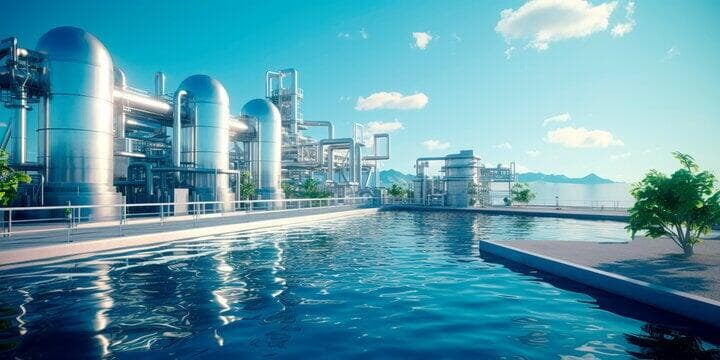As the global demand for freshwater rises, countries around the world are searching for innovative ways to secure reliable drinking water supplies. Among the potential solutions, desalination—the process of removing salt and impurities from seawater—stands out. But can desalination truly address the growing drinking water shortage? Let's explore the potential of desalination, its challenges, and its role in water sustainability.
Understanding Desalination
Understanding Desalination
Desalination primarily uses two methods: thermal distillation and reverse osmosis. In thermal distillation, seawater is heated until it evaporates, leaving the salt behind, and then it is condensed back into freshwater. Reverse osmosis, on the other hand, uses high-pressure pumps to push seawater through membranes that filter out salt and other impurities.
Both methods produce freshwater suitable for drinking, irrigation, and industrial use, but they come with distinct energy and environmental costs.
The Potential of Desalination
The Potential of Desalination
- Abundant Resource: With oceans covering 70% of the Earth's surface, seawater is virtually limitless. Desalination taps into this vast resource, potentially providing drinking water to coastal cities where freshwater sources are scarce.
- Drought-Resistant: Unlike groundwater or surface water sources, desalination isn’t affected by seasonal droughts or decreasing rainfall. This makes it a reliable option, particularly for arid regions.
- Improving Technologies: Advancements in desalination technologies are making the process more efficient and less costly. Recent innovations have also focused on reducing the environmental impact of desalination plants, making it a more sustainable option than ever before.
Challenges of Desalination
Challenges of Desalination
Despite its potential, desalination is not a perfect solution, and several challenges remain:
- Energy Consumption: Desalination is an energy-intensive process, especially reverse osmosis, which requires high pressures to push water through semi-permeable membranes. The energy required contributes to higher operational costs and can have significant environmental impacts if fossil fuels are the primary energy source.
- Environmental Impact: The byproduct of desalination, known as brine, is a highly concentrated salt solution. When released back into the ocean, it can harm marine life by increasing salinity levels and potentially introducing chemicals used in the desalination process.
- Cost of Infrastructure: Building and maintaining desalination plants is expensive. The initial investment can be prohibitive for many developing nations, which are often the ones most affected by water scarcity.
- Water Distribution: Even if desalination plants produce large quantities of freshwater, effective distribution systems are needed to ensure that the water reaches those in need. In areas with poor infrastructure, this remains a significant hurdle.

Case Studies: Where Desalination Works
Case Studies: Where Desalination Works
Desalination has proven effective in countries facing extreme water shortages. For instance:
- Saudi Arabia: With limited freshwater resources, Saudi Arabia has invested heavily in desalination, producing around 50% of its drinking water from desalination plants. This has allowed the country to sustain its growing population and industries despite its arid climate.
- Israel: Israel has also turned to desalination, implementing some of the most advanced technologies. Today, desalination provides a substantial portion of Israel’s drinking water, with significant portions allocated to agriculture and industry.
- California, USA: In the face of ongoing droughts, California has explored desalination to diversify its water sources. While not yet a primary source, several plants along the coast are part of the state's long-term water strategy.
The Future of Desalination
The Future of Desalination
The future of desalination looks promising, particularly as renewable energy sources are integrated into desalination plants, reducing their environmental impact and operating costs. Solar-powered desalination and other innovative techniques are being tested to address the challenges of traditional desalination. Additionally, improved brine management techniques are helping to mitigate the impact on marine ecosystems.
To know about more such improved and innovative techniques plan your visit to the 18<sup>th</sup> Water Expo in Chennai from 26 – 28 February 2025 at Chennai Trade Centre, Nandambakkam. Get a feel and see live demos of techniques and meet experts to gather information.
While desalination alone may not entirely solve the global water crisis, it is an essential component of a diversified approach to water security. It works best in combination with water conservation, recycling, and efficient usage policies. In areas where freshwater sources are drying up, desalination can play a crucial role in ensuring a steady supply of drinking water.
Conclusion
Conclusion
Desalination offers a valuable solution for areas facing severe water shortages, but it is not a one-size-fits-all answer. The costs, energy requirements, and environmental impacts must be weighed against the benefits. However, with continuous improvements in technology and a push towards more sustainable practices, desalination holds significant promise as part of a larger strategy to address global water scarcity.
By investing in desalination technology, countries can ensure a more resilient and dependable water supply, especially as climate change and population growth continue to strain existing resources. As we move forward, balancing desalination with sustainable practices will be key in meeting the world's water needs.

